Exploring Determinants of Urban Form in China through an Empirical Study among 115 Cities
Abstract
:1. Introduction
2. Literature Review
3. Data and Methodology
3.1. Study Area and Data
3.2. Urban Form Metrics
3.3. Determinants
4. Results
4.1. Comparison of Urban Form
4.2. Analysis of Determinants
5. Discussion
6. Conclusions
Author Contributions
Funding
Conflicts of Interest
References
- Clifton, K.; Ewing, R.; Knaap, G.J.; Song, Y. Quantitative analysis of urban form: A multidisciplinary review. J. Urban. 2008, 1, 17–45. [Google Scholar] [CrossRef]
- Bartholomew, K.; Ewing, R. Land use–transportation scenarios and future vehicle travel and land consumption: A meta-analysis. J. Am. Plan. Assoc. 2008, 75, 13–27. [Google Scholar] [CrossRef]
- Ewing, R.; Cervero, R. Travel and the built environment: A meta-analysis. J. Am. Plan. Assoc. 2010, 76, 265–294. [Google Scholar] [CrossRef]
- Brand, C.; Tran, M.; Anable, J. The UK transport carbon model: An integrated life cycle approach to explore low carbon futures. Energy Policy 2012, 41, 107–124. [Google Scholar] [CrossRef] [Green Version]
- Frank, L.D.; Sallis, J.F.; Conway, T.L.; Chapman, J.E.; Saelens, B.E.; Bachman, W. Many pathways from land use to health: Associations between neighborhood walkability and active transportation, body mass index, and air quality. J. Am. Plan. Assoc. 2006, 72, 75–87. [Google Scholar] [CrossRef]
- Loh, T.H. Understanding Urban Development and Water Quality through Scenarios; The University of North Carolina: Chapel Hill, NC, USA, 2012. [Google Scholar]
- McCarty, J.; Kaza, N. Urban form and air quality in the United States. Landsc. Urban Plan. 2015, 139, 168–179. [Google Scholar] [CrossRef]
- OECD. OECD Economic Surveys: China 2013; OECD Publishing: Paris, France, 2013. [Google Scholar]
- Chen, H.; Jia, B.; Lau, S.S. Sustainable urban form for Chinese compact cities: Challenges of a rapid urbanized economy. Habitat Int. 2008, 32, 28–40. [Google Scholar] [CrossRef]
- Chen, Y.; Li, X.; Zheng, Y.; Guan, Y.; Liu, X. Estimating the relationship between urban forms and energy consumption: A case study in the Pearl River Delta, 2005–2008. Landsc. Urban Plan. 2011, 102, 33–42. [Google Scholar] [CrossRef]
- Yang, J.; Shen, Q.; Shen, J.; He, C. Transport impacts of clustered development in Beijing: Compact development versus overconcentration. Urban Stud. 2012, 49, 1315–1331. [Google Scholar] [CrossRef]
- Yuan, M.; Song, Y.; Huang, Y.; Hong, S.; Huang, L. Exploring the Association between Urban Form and Air Quality in China. J. Plan. Educ. Res. 2017. [Google Scholar] [CrossRef]
- Churchman, A. Disentangling the concept of density. J. Plan. Lit. 1999, 13, 389–411. [Google Scholar] [CrossRef]
- Galster, G.; Hanson, R.; Ratcliffe, M.R.; Wolman, H.; Coleman, S.; Freihage, J. Wrestling sprawl to the ground: Defining and measuring an elusive concept. Hous. Policy Debate 2001, 12, 681–717. [Google Scholar] [CrossRef]
- Ewing, R.; Pendall, R.; Chen, D. Measuring Sprawl and Its Impact. Smart Growth Am. 2002, 57, 320–326. [Google Scholar]
- Song, Y.; Knaap, G.J. Measuring urban form: Is Portland winning the war on sprawl? J. Am. Plan. Assoc. 2004, 70, 210–225. [Google Scholar] [CrossRef]
- Zhong, C.; Arisona, S.M.; Huang, X.; Batty, M.; Schmitt, G. Detecting the dynamics of urban structure through spatial network analysis. Int. J. Geogr. Inf. Sci. 2014, 28, 2178–2199. [Google Scholar] [CrossRef]
- Gustafson, E.J. Quantifying landscape spatial pattern: What is the state of the art? Ecosystems 1998, 1, 143–156. [Google Scholar] [CrossRef]
- Turner, M.G.; Gardner, R.H.; O’neill, R.V. Landscape Ecology in Theory and Practice: Pattern and Process; Springer Science & Business Media: New York, NY, USA, 2001. [Google Scholar]
- Bereitschaft, B.; Debbage, K. Urban form, air pollution, and CO2 emissions in large US metropolitan areas. Prof. Geogr. 2013, 65, 612–635. [Google Scholar] [CrossRef]
- Bechle, M.J.; Millet, D.B.; Marshall, J.D. Effects of income and urban form on urban NO2: Global evidence from satellites. Environ. Sci. Technol. 2011, 45, 4914–4919. [Google Scholar] [CrossRef] [PubMed]
- Clark, L.P.; Millet, D.B.; Marshall, J.D. Air quality and urban form in US urban areas: Evidence from regulatory monitors. Environ. Sci. Technol. 2011, 45, 7028–7035. [Google Scholar] [CrossRef] [PubMed]
- Ou, J.; Liu, X.; Li, X.; Chen, Y. Quantifying the relationship between urban forms and carbon emissions using panel data analysis. Landsc. Ecol. 2013, 28, 1889–1907. [Google Scholar] [CrossRef]
- Wang, X.S.; Liu, J.Y.; Zhuang, D.F.; Wang, L. Spatial-temporal Changes of Urban Spatial Morphology in China. Acta Geogr. Sin. 2005, 60, 392–400. [Google Scholar]
- Brueckner, J.K. Urban sprawl: Diagnosis and remedies. Int. Reg. Sci. Rev. 2000, 23, 160–171. [Google Scholar] [CrossRef]
- Song, Y.; Zenou, Y. Property tax and urban sprawl: Theory and implications for US cities. J. Urban Econ. 2006, 60, 519–534. [Google Scholar] [CrossRef] [Green Version]
- Ke, S.; Song, Y.; He, M. Determinants of urban spatial scale: Chinese cities in transition. Urban Stud. 2009, 46, 2795–2813. [Google Scholar] [CrossRef]
- Deng, X.; Huang, J.; Rozelle, S.; Uchida, E. Growth, population and industrialization, and urban land expansion of China. J. Urban Econ. 2008, 63, 96–115. [Google Scholar] [CrossRef]
- Oueslati, W.; Alvanides, S.; Garrod, G. Determinants of urban sprawl in European cities. Urban Stud. 2015, 52, 1594–1614. [Google Scholar] [CrossRef] [PubMed] [Green Version]
- Schneider, A.; Mertes, C.M.; Tatem, A.J.; Tan, B.; Sulla-Menashe, D.; Graves, S.J.; Patel, N.N.; Horton, J.A.; Gaughan, A.E.; Rollo, J.T.; et al. A new urban landscape in East–Southeast Asia, 2000–2010. Environ. Res. Lett. 2015, 10, 034002. [Google Scholar] [CrossRef] [Green Version]
- Sutton, P.C.; Goetz, A.R.; Fildes, S.; Forster, C.; Ghosh, T. Darkness on the edge of town: Mapping urban and peri-urban Australia using nighttime satellite imagery. Prof. Geogr. 2010, 62, 119–133. [Google Scholar] [CrossRef]
- Jiang, B. Head/tail breaks for visualization of city structure and dynamics. Cities 2015, 43, 69–77. [Google Scholar] [CrossRef] [Green Version]
- Mertes, C.M.; Schneider, A.; Sulla-Menashe, D.; Tatem, A.J.; Tan, B. Detecting change in urban areas at continental scales with MODIS data. Remote. Sens. Environ. 2015, 158, 331–347. [Google Scholar] [CrossRef] [Green Version]
- Randolph, J. Environmental land use planning and management. Environ. Land Use Plan. Manag. 2004, 24, 172–185. [Google Scholar]
- Seto, K.C.; Kaufmann, R.K. Modeling the drivers of urban land use change in the Pearl River Delta, China: Integrating remote sensing with socioeconomic data. Land Econ. 2003, 79, 106–121. [Google Scholar] [CrossRef]
- Gu, C.; Hu, L.; Cook, I.G. China’s urbanization in 1949–2015: Processes and driving forces. Chin. Geogr. Sci. 2017, 27, 847–859. [Google Scholar] [CrossRef]
- Wu, F. Globalization and the Chinese City; Routledge: London, UK, 2006. [Google Scholar]
- Gu, C.; Han, S. Climate change and China’s mega urban regions. Front. Arch. Civ. Eng. China 2010, 4, 418–430. [Google Scholar] [CrossRef]
- Jiating, W.; Juntao, Z. Measurement on the urban spreading in China: Empirical study based on the panel data of 35 large and middle cities. Economist 2010, 10, 56–63. [Google Scholar]
- Chengri, D. Growth, Structure, and Efficiency: Assessment of Spatial Development Patterns in Chinese Cities. Planners 2009, 24, 35–39. [Google Scholar]
- Zhao, Y. Urbanization 2.0 and Transition of Planning: Explanation based on a Two-Phase Model. City Plan. Rev. 2017, 41, 85–93. [Google Scholar]
- Heilig, G.K. (Ed.) World Urbanization Prospects: The 2014 Revision; United Nations, Department of Economic and Social Affairs (DESA), Population Division, Population Estimates and Projections Section: New York, NY, USA, 2014. [Google Scholar]
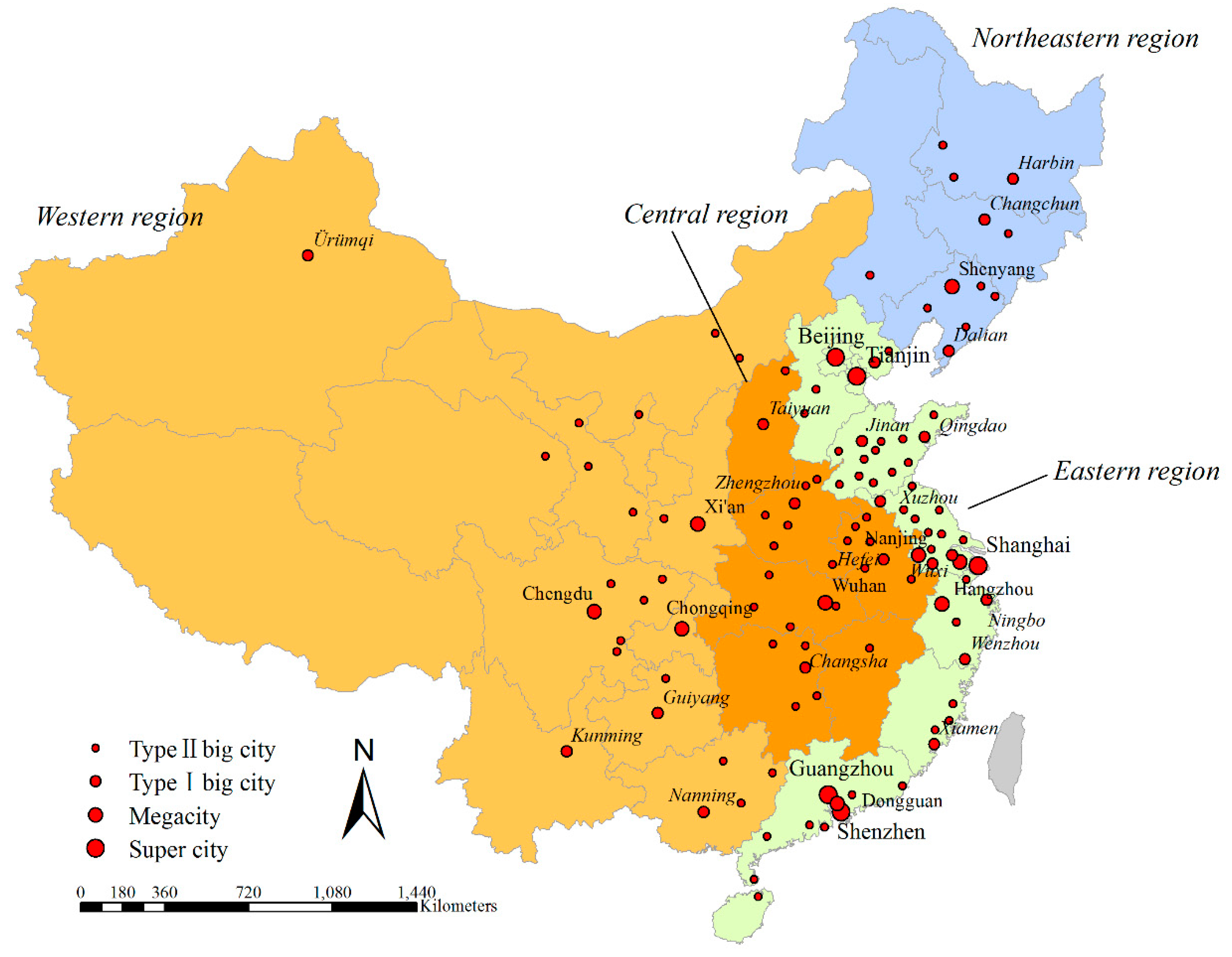
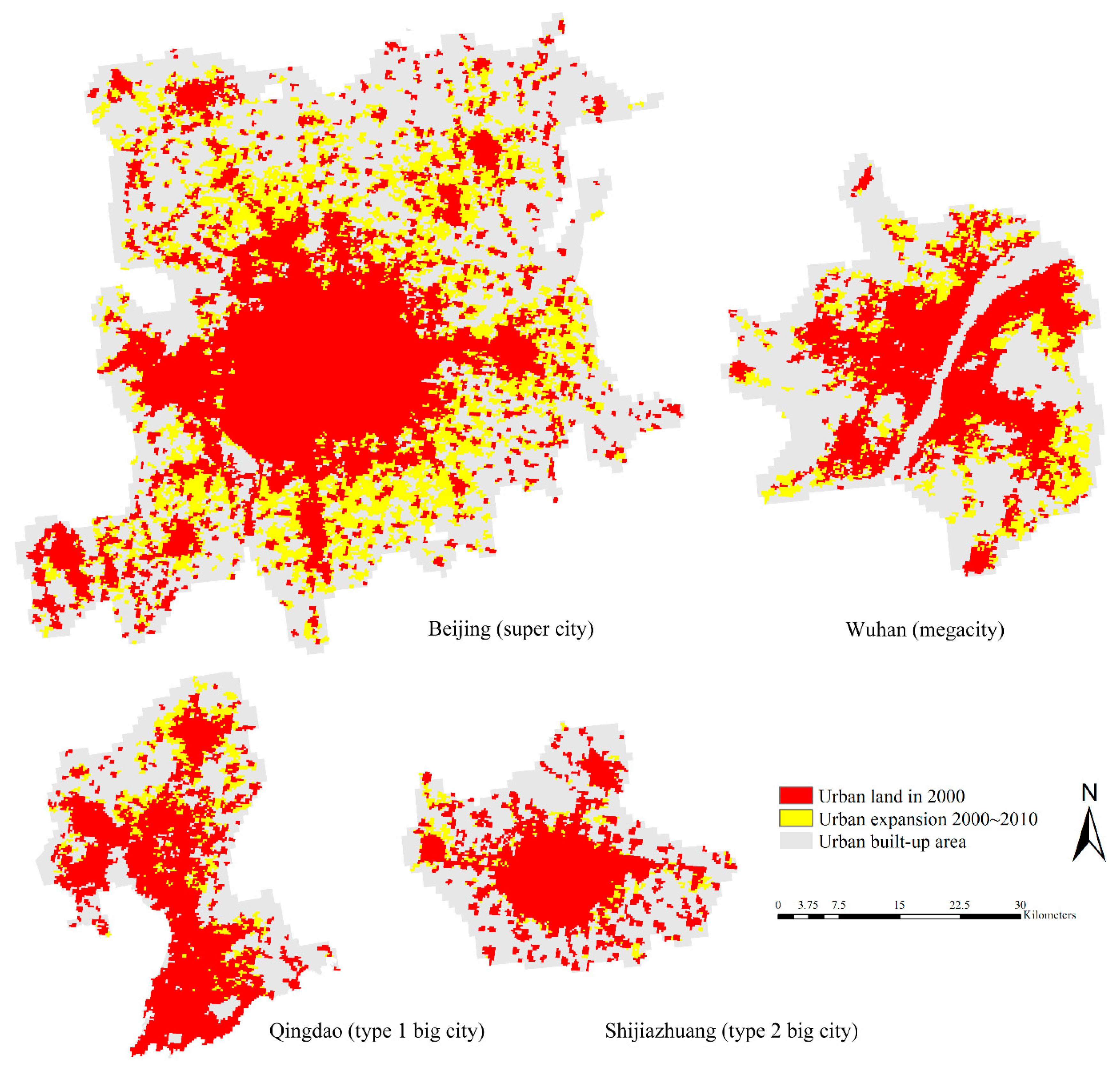
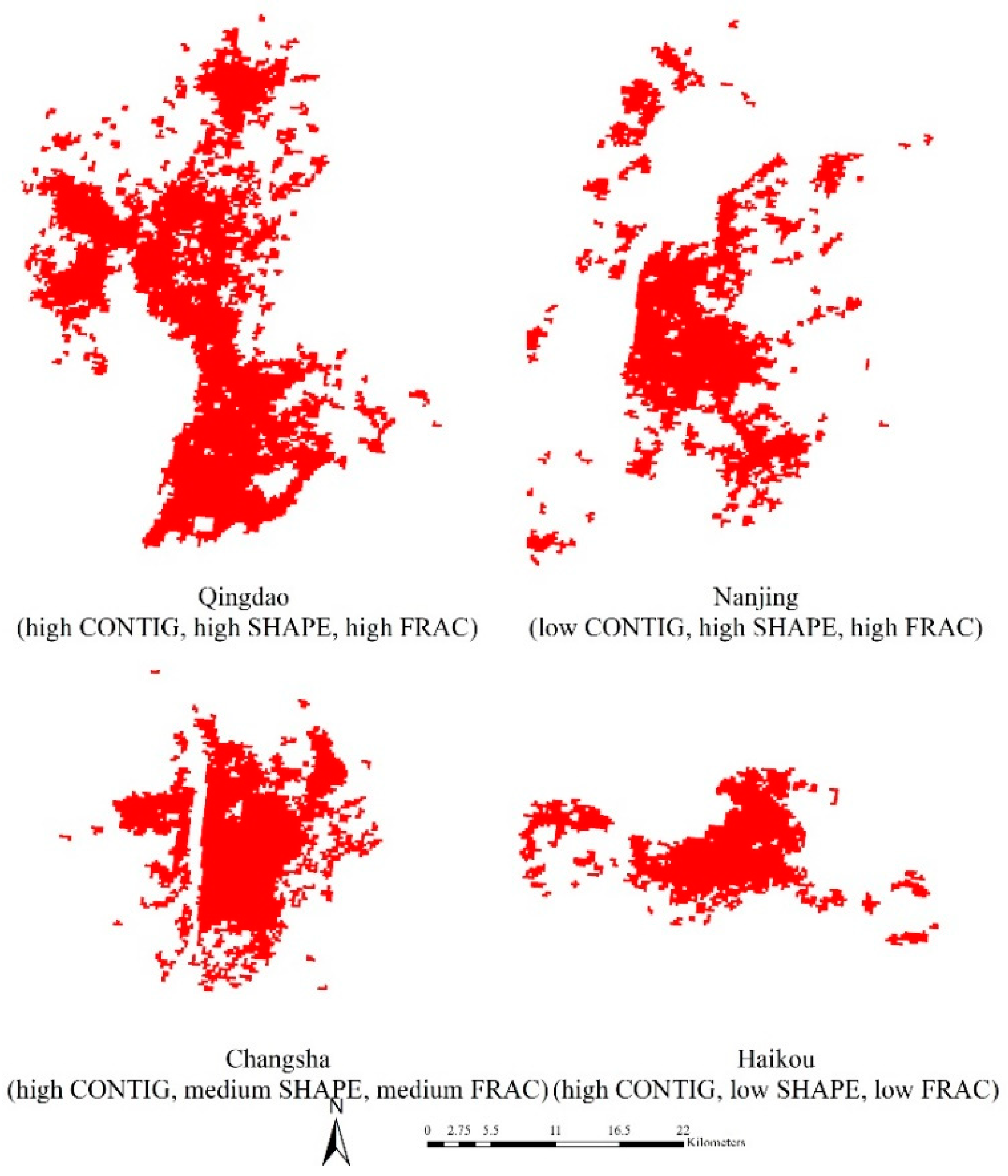
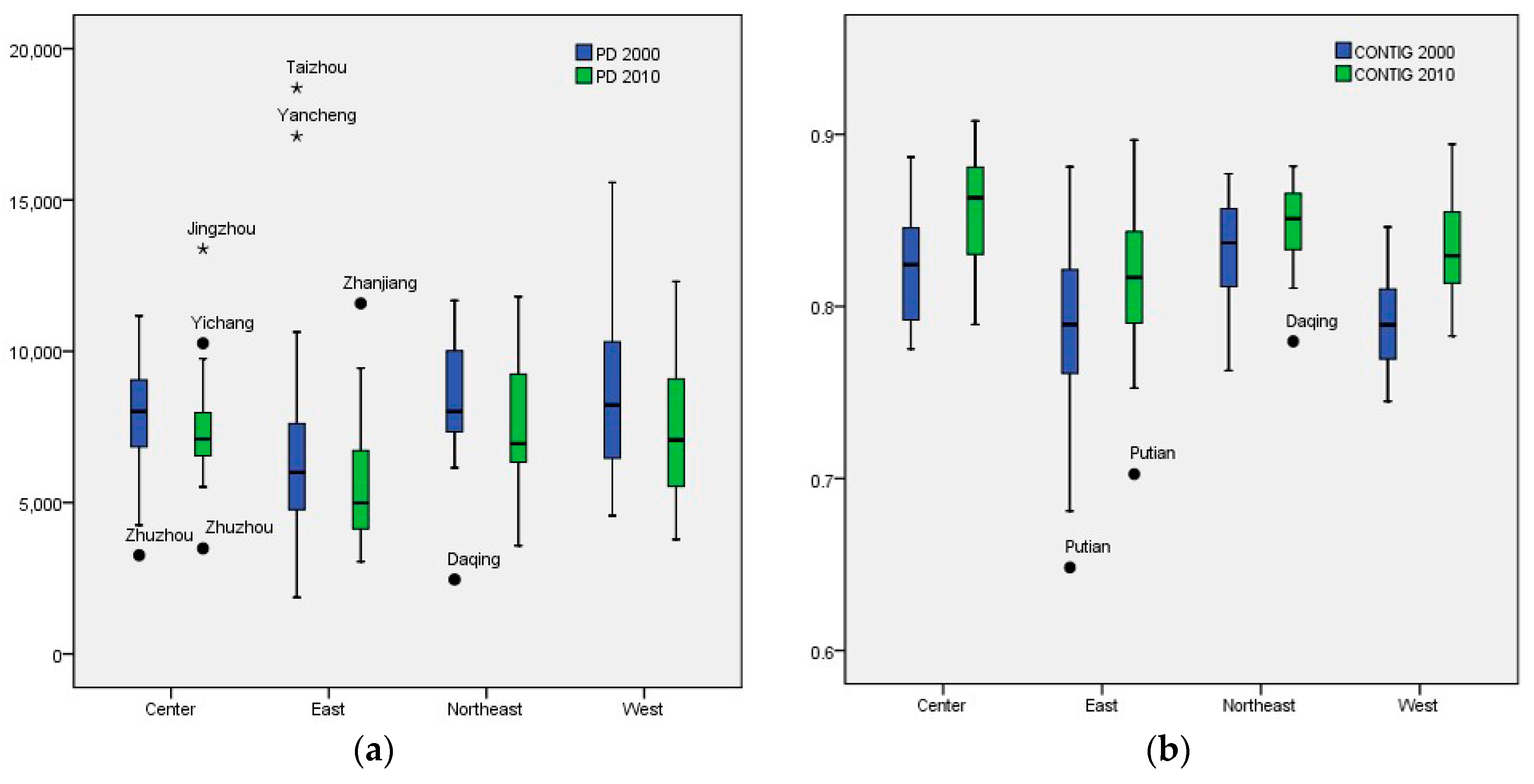
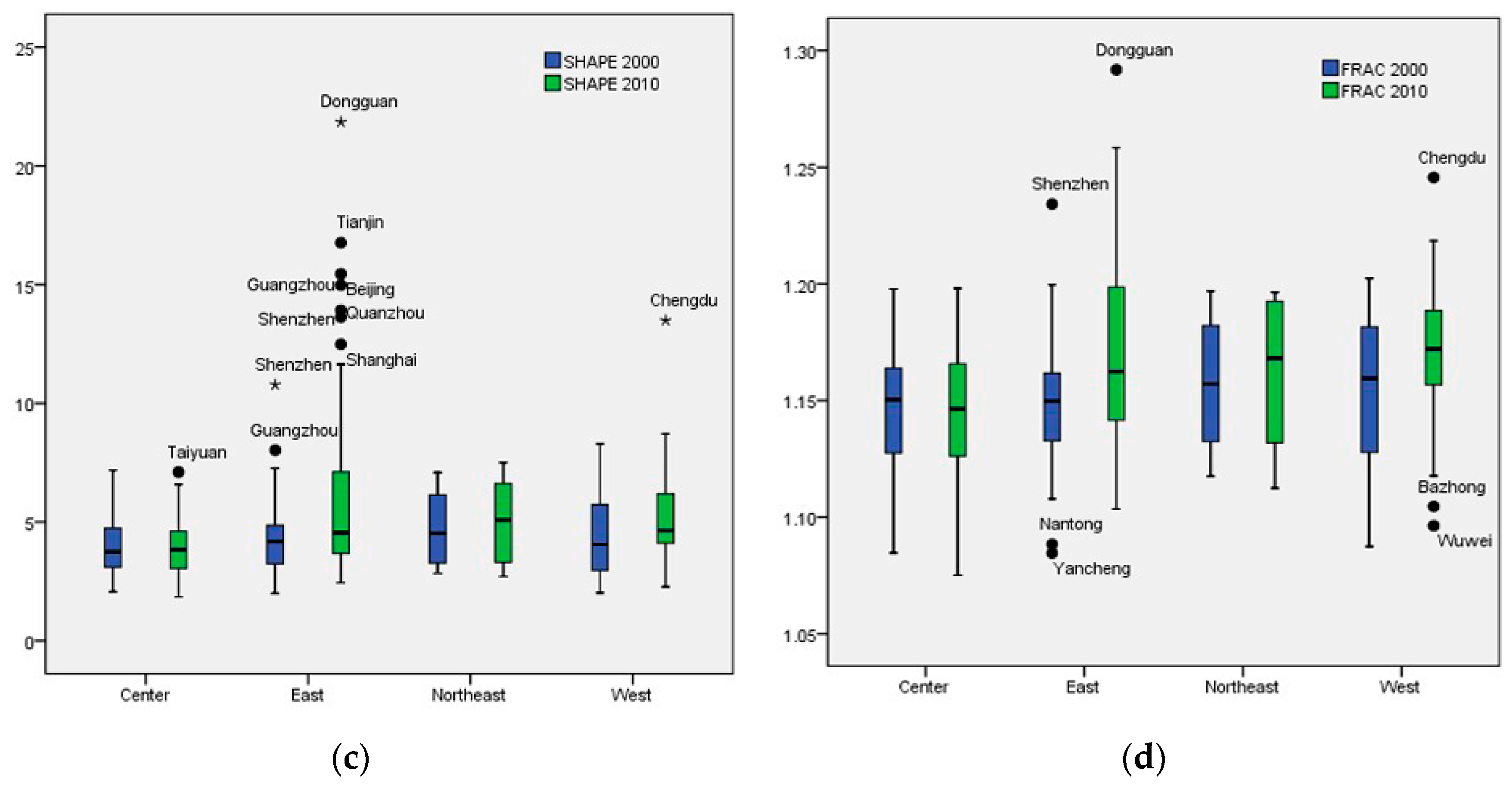

| Variables | Description | Data Source | Unit |
|---|---|---|---|
| PD | Ratio of population to area (km2) | 2000/2010 LandScan population data | Persons/km2 |
| CONTIG | Average contiguity value minus 1, divided by the sum of the template values minus 1 | Urban expansion data between 2000 and 2010 from WorldBank | |
| SHAPE | Patch perimeter divided by the square root of patch area, adjusted by a constant to adjust for a square standard | ||
| FRAC | Two times the logarithm of patch perimeter divided by the logarithm of patch area | ||
| GDP | Gross Domestic Production | China City Statistical Yearbook 2000 and 2010 | 10,000 yuan |
| Population | Population | 2000/2010 LandScan population data | Persons |
| Bus | Number of buses per 10,000 people | China City Statistic Yearbook 2000 and 2010 | Vehicles |
| GDP2Share | Share of industrial sector in GDP | % | |
| GDP3Share | Share of service sector in GDP | % | |
| UrbanArea | Area of urban land | Urban expansion data between 2000 and 2010 from WorldBank | km2 |
| Elevation | Average elevation in the urban built-up area | Cold and Arid Regions Sciences Data Center | m |
| Slope | Average slope in the urban built-up area | Degree | |
| WaterShare | Ratio of inland water to overall urban built-up area | DIVA-GIS | % |
| Variables (Year) | Minimum | Maximum | Mean | Std. Deviation | N |
|---|---|---|---|---|---|
| PD (2000) | 1870 | 18,700 | 7460 | 2991 | 115 |
| PD (2010) | 3050 | 13,384 | 6586 | 2198 | 115 |
| CONTIG (2000) | 0.65 | 0.89 | 0.80 | 0.04 | 115 |
| CONTIG (2010) | 0.70 | 0.91 | 0.83 | 0.04 | 115 |
| SHAPE (2000) | 2.00 | 10.78 | 4.29 | 1.57 | 115 |
| SHAPE (2010) | 1.85 | 21.85 | 5.51 | 3.31 | 115 |
| FRAC (2000) | 1.08 | 1.23 | 1.15 | 0.03 | 115 |
| FRAC (2010) | 1.08 | 1.29 | 1.17 | 0.04 | 115 |
| GDP (2000) | 199,586 | 40,986,400 | 3,354,693 | 5,270,149 | 113 |
| GDP (2010) | 1,054,562 | 169,715,503 | 17,151,345 | 25,420,000 | 115 |
| Population (2000) | 74,120 | 10,336,932 | 1,173,041 | 1,487,203 | 115 |
| Population (2010) | 93,231 | 13,489,355 | 1,638,764 | 2,010,851 | 115 |
| Bus (2000) | 0.36 | 91.97 | 7.31 | 9.00 | 112 |
| Bus (2010) | 0.43 | 103.11 | 9.60 | 10.20 | 115 |
| GDP2Share (2000) | 15.90 | 92.30 | 49.46 | 10.65 | 113 |
| GDP2Share (2010) | 19.61 | 85.45 | 51.15 | 10.69 | 115 |
| GDP3Share (2000) | 7.30 | 71.70 | 43.48 | 9.37 | 113 |
| GDP3Share (2010) | 14.01 | 78.66 | 43.87 | 11.20 | 115 |
| UrbanArea (2000) | 11.56 | 1419.00 | 174.45 | 204.96 | 115 |
| UrbanArea (2010) | 12.00 | 2159.25 | 270.61 | 343.12 | 115 |
| Elevation | 2.00 | 2328.00 | 227.35 | 424.80 | 115 |
| Slope | 0.03 | 4.12 | 0.72 | 0.73 | 115 |
| WaterShare | 0.00 | 27.67 | 3.62 | 5.37 | 115 |
| Metric | Mean | S.D. | t | Sig. | Smallest Five | Largest Five |
|---|---|---|---|---|---|---|
| PD | −875 | 2421 | −3.874 | 0.000 | Taizhou, Yancheng, Tianshui, Zigong, Wuwei | Jingzhou, Shenzhen, Zhuhai, Dongguan, Wenzhou |
| CONTIG | 0.033 | 0.026 | 13.678 | 0.000 | Yangzhou, Zhuzhou, Jiaxing, Taizhou, Qiqihar | Dongguan, Changde, Ningbo, Kunming, Changsha |
| SHAPE | 1.213 | 2.402 | 5.413 | 0.000 | Yueyang, Wuhan, Changsha, Nanyang, Haikou | Dongguan, Tianjin, Beijing, Suzhou, Quanzhou |
| FRAC | 0.015 | 0.027 | 6.219 | 0.000 | Yueyang, Nanyang, Changsha, Haikou, Ezhou | Dongguan, Suzhou, Ningbo, Hangzhou, Beijing |
| Variable | CONTIG | SHAPE | FRAC | |||
|---|---|---|---|---|---|---|
| 2000 | 2010 | 2000 | 2010 | 2000 | 2010 | |
| GDP | −0.493 | −0.326 | −0.374 | −0.670 | −0.407 | −0.626 |
| (0.067) | (0.352) | (0.034) | (0.000) | (0.063) | (0.006) | |
| Population | 1.249 | 1.191 | 0.282 | −0.112 | 0.331 | 0.091 |
| (0.000) | (0.006) | (0.197) | (0.613) | (0.224) | (0.738) | |
| Bus | 0.242 | 0.050 | 0.395 | 0.198 | 0.318 | 0.174 |
| (0.055) | (0.647) | (0.000) | (0.001) | (0.002) | (0.015) | |
| GDP2Share | −0.174 | −0.051 | 0.058 | 0.076 | 0.122 | 0.451 |
| (0.219) | (0.810) | (0.529) | (0.494) | (0.288) | (0.001) | |
| GDP3Share | −0.141 | 0.168 | 0.106 | −0.051 | 0.163 | 0.354 |
| (0.365) | (0.489) | (0.299) | (0.686) | (0.201) | (0.025) | |
| UrbanArea | −0.869 | −0.974 | 0.618 | 1.550 | 0.467 | 1.138 |
| (0.000) | (0.006) | (0.000) | (0.000) | (0.018) | (0.000) | |
| Elevation | −0.003 | 0.106 | 0.042 | 0.013 | 0.045 | 0.019 |
| (0.983) | (0.376) | (0.596) | (0.831) | (0.645) | (0.805) | |
| Slope | −0.055 | −0.108 | 0.071 | 0.058 | 0.118 | 0.112 |
| (0.643) | (0.343) | (0.359) | (0.328) | (0.224) | (0.126) | |
| WaterShare | −0.092 | −0.050 | 0.009 | 0.034 | 0.070 | 0.013 |
| (0.315) | (0.586) | (0.876) | (0.479) | (0.351) | (0.821) | |
| Ajusted R2 | 0.101 | 0.104 | 0.616 | 0.755 | 0.404 | 0.632 |
| (0.017) | (0.013) | (0.000) | (0.000) | (0.000) | (0.000) | |
| Variable | Standardized B, Sig. | |||||
|---|---|---|---|---|---|---|
| CONTIG | SHAPE | FRAC | ||||
| GDP | −0.564 | (0.005) | −0.467 | (0.001) | −0.589 | (0.001) |
| Population | 0.543 | (0.000) | 0.244 | (0.012) | −0.019 | (0.874) |
| Bus | −0.010 | (0.916) | 0.030 | (0.634) | 0.110 | (0.168) |
| GDP2Share | 0.044 | (0.644) | 0.023 | (0.853) | −0.198 | (0.205) |
| GDP3Share | 0.086 | (0.353) | −0.035 | (0.782) | −0.221 | (0.157) |
| UrbanArea | 0.382 | (0.054) | 1.008 | (0.000) | 1.117 | (0.000) |
| Ajusted R2 | 0.194 | (0.000) | 0.624 | (0.000) | 0.398 | (0.000) |
© 2018 by the authors. Licensee MDPI, Basel, Switzerland. This article is an open access article distributed under the terms and conditions of the Creative Commons Attribution (CC BY) license (http://creativecommons.org/licenses/by/4.0/).
Share and Cite
Yuan, M.; Song, Y.; Guo, L. Exploring Determinants of Urban Form in China through an Empirical Study among 115 Cities. Sustainability 2018, 10, 3648. https://doi.org/10.3390/su10103648
Yuan M, Song Y, Guo L. Exploring Determinants of Urban Form in China through an Empirical Study among 115 Cities. Sustainability. 2018; 10(10):3648. https://doi.org/10.3390/su10103648
Chicago/Turabian StyleYuan, Man, Yan Song, and Liang Guo. 2018. "Exploring Determinants of Urban Form in China through an Empirical Study among 115 Cities" Sustainability 10, no. 10: 3648. https://doi.org/10.3390/su10103648





